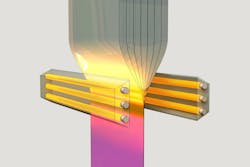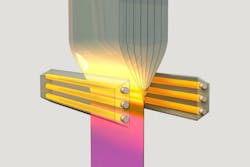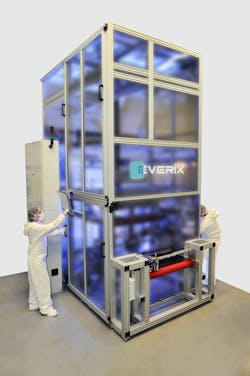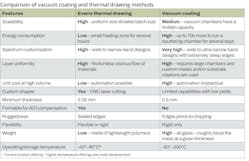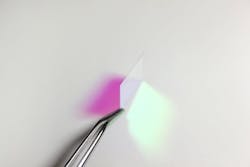One of the most common components in an optical system is the optical filter, which transmits specific wavelengths to the sample or detector and absorbs or reflects the rest. Although new methods for wavelength selection (like holographic metamaterials and volume Bragg gratings) have appeared on the scene in the last 15 years, most established filter companies manufacture layered interference filters using the traditional method.
All interference filters consist of alternating layers of materials with high and low indices of refraction; the relative thickness of these layers determines the spectral performance of the filter. Traditional filter manufacturers use vacuum coating chambers to prepare each layer, one at a time. Everix is changing this paradigm by using a polymer thermal drawing process to prepare all the layers simultaneously (see Fig. 1).
In an interference filter, each layer interface transmits and reflects some fraction of light, which results in wavelength-specific constructive and destructive interference that tunes whether a given spectral band will pass through the filter or be reflected by it.1 Most interference filters are designed with materials that don’t absorb the light; it is either reflected or transmitted.
Manufacturers have used vacuum processes to prepare interference filters for decades. But now, Everix is perfecting a highly scalable method of producing high-performance plastic interference filters that uses a technique similar to fiber drawing (see Fig. 2). First, a large polymer preform is assembled with layers in the correct proportion. Then, this preform is heated and pulled (thermally drawn) in one direction to make a sheet that is spectrally mapped, inspected, and cut into filters.2-5 Many variables, including the heating profile, speed, web tension, etc., are controlled throughout the process. The company, which holds over 30 patents in this area, has continually improved this process since 2015 to monitor and control all the parameters simultaneously during the draw.
Other processes to manufacture lower-performance but large-format plastic filters have also emerged, though most often for the large-area window film and display markets. Led by 3M and Toray films, these polymer sheets are prepared with co-extrusion6 and also use interference physics to obtain visually appealing reflective surfaces and perform fundamental functions like infrared (IR) blocking. However, these filters are used primarily for aesthetics or with other higher-performance filter elements, so their spectral requirements are much more relaxed than the thermally drawn filters.
Compared to vacuum-based methods
The original, vacuum-based filter manufacturing process, established over 60 years ago, uses thermally evaporated films, often protected with epoxy and a coverslip, while more modern methods, over the last 15 to 20 years, use ion-assist and sputtering to produce hard oxide films on the surface of a glass substrate. The early laminated filters were often several millimeters thick with several layers of glass, coatings, and epoxy to achieve the desired spectrum. The surface-coated filters are much thinner (typically 1 to 2 mm), but are susceptible to scratches, chips, breakage, and surface contamination. In contrast, Everix filters are formed from and embedded in polymer layers that are very thin, somewhat flexible, and less sensitive to chipping and breakage. Also, because the interference layers are embedded between thicker acrylic covers, small scratches in the cover will not affect the overall performance. The total filter thickness is typically 0.05 to 0.5 mm.
Both vacuum-deposited and drawn polymer filters work using the same principle (interference between hundreds of layers), so either method can achieve excellent performance (see table). However, the new thermally drawn approach yields several benefits:
Speed. As described above, vacuum deposition methods can take several days to complete a filter—especially when producing a complicated design. In particular, the sputtering methods are very slow. In contrast, the new approach assembles the polymer preform as a monolith and creates filters in a one-step process, going from preform to filters within a few hours.
Scalability. The size of the vacuum chamber, typically a capacity of about 1 m2, limits the quantity of filters that the vacuum deposition process can make. With the Everix process, the size of the preform dictates the lot size so scaling is simple.
Flexibility. Besides the raw filter draw capacity, the new method can leverage other in-line processing methods, including in-line spectral measuring and laser cutting. Everix uses CNC laser cutting and can cut nearly any shape the customer desires in a fraction of a second. The laser cutter also seals the edges of the filter so there is no delamination of the parts over time. The company has spent years perfecting the laser-cutting process of its filters to minimize edge effects and produce sealed edges.
By comparison, vacuum-coated plates must be unloaded before they are spectrally measured. Also, standard glass-cutting techniques like mechanical cutting (dicing) and core drilling are typically used, so custom shapes are more challenging to achieve with good yield. Core drilling, in particular, is a very slow process involving blocking the glass filters between sacrificial layers to reduce edge chipping, followed by cutting with a hole saw, deblocking, and cleaning.
Form factor. Because thermally drawn filters lack a substrate, they are 2 to 10x thinner than typical glass-based interference filters (see Fig. 3). They are also lighter-weight because of their thickness and because they are made primarily of optical-grade acrylic (a much lighter-weight material than glass). Additionally, the filters can have adhesive-backing added or can be epoxied to other components for unique optical design possibilities. Finally, it is well known that interference filters exhibit a blue spectral shift as a function of the angle of incidence (AOI). Because they are made of thermoplastics, Everix filters can be 3D-formed to reduce or eliminate AOI effects on the spectrum.
Compared to absorbance filters
The oldest optical filtering method is the absorbance filter, used to create the “stained glass” used in church windows and decorative arts for thousands of years before being used by scientists and engineers. This method was the only option for wavelength selection before the advent of vacuum chambers and interference filters. While absorbance filters do not exhibit dramatic AOI effects and can be used successfully for long-wavelength range blocking, their use is limited by the solubility of the chromophore in the matrix and the availability of suitable chromophores.
Many interference filter companies use colored absorbance filter glass in conjunction with interference stacks for long-wavelength range blocking. Interference layers are deposited directly onto the colored glass, or the filter substrate is epoxied onto a colored glass, to provide the required blocking. In contrast, Everix and its custom-material supplier formulate custom dye-doped plastics to incorporate into the polymer filter design directly. These hybrid filters combine both absorption and interference7 drawn together in a single unit. Because they are encapsulated, the polymer absorbance filters do not exhibit degradation, like surface fogging, which is common in many colored glasses.
Everix provides high-performance optical filters at scale for applications in the consumer market (e.g., AR/VR, wearable health monitoring), miniature and point-of-care diagnostics (e.g., endoscopes, portable PCR machines), and IoT and other low-cost, lightweight sensors (e.g., disposable food sensors, drone-mounted sensors), serving these markets with filters that exhibit high performance, lower weight, thinner form factor, and lower cost in volume.
REFERENCES
1. H. A. Macleod, Thin-Film Optical Filters, Fourth ed., Boca Raton, FL: CRC Press (2010).
2. E. Banaei, “Method of thermally drawings structured sheets,” U.S. Patent 10,287,203 B2 (May 14, 2019).
3. E. Banaei, “Method of thermally drawing structured sheets,” Europe Patent EP2 958 865 B1, (Apr. 28, 2021).
4. E. Banaei, “Method of thermally drawing structured sheets,” U.S. Patent 9,994,476 B2 (Jun. 12, 2018).
5. E. Banaei, “Method of thermally drawing structured sheets,” U.S. Patent 9,597,829 B2 (Mar. 21, 2017).
6. Y. N. F. C. N. Furuno, “Apparatus and method for manufacturing laminated sheet,” U.S. Patent US 2008/0277059 A1 (2008).
7. E. Banaei, J. Boga, and C. Bisson, “Flexible, ultra-thin, hybrid absorptive-reflective thin-film filters and methods of making the same,” U.S. Patent 11,435,508 B2 (Sep. 6, 2022).
